|
Getting your Trinity Audio player ready...
|
This was a good idea, this was a good idea, this was a good idea, I kept telling myself as the notorious Front Range wind fest continued. Absent the wind, it really was. I’d decided to get in some glorious backcountry skiing off a major peak along the Continental Divide in northern Colorado. The wind, however, seemed determined to try and obliterate my plans. For a while, it seemed like the 30-35 mph gusts were going to win, but I had a few factors on my side, including a small front-facing pack, which was doing a consistently great job of keeping my chest warm in the frigid temperatures.
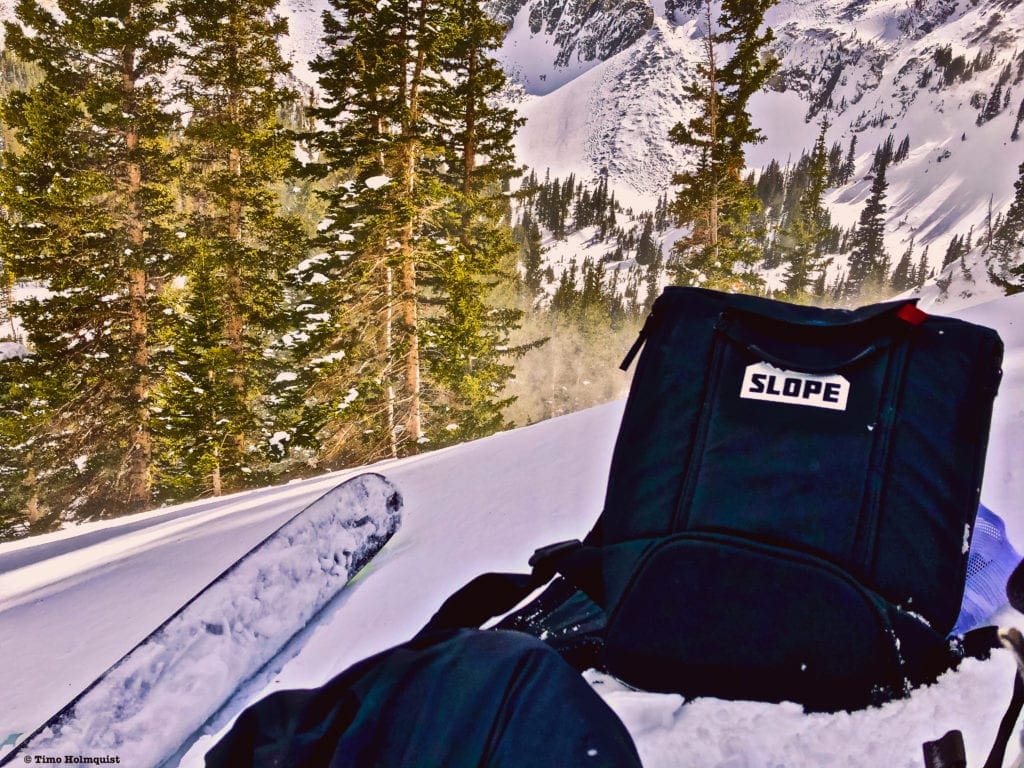
The Slope Pro-180x Chest Pack in the backcountry.
Initially, I was doubtful about the Slope Gear Pro-180x Chest Pack. When I head out to backcountry ski, I usually just bring my regular backpack and a couple of Nalgene’s because I’m a creature of habit. If I need water, I dutifully take the pack off and unclip the bottles. Having the Chest Pack and a water bottle within reach made me realize how much time my usual water routine was costing me. With my normal backpack, I’d stop, take the pack off, unclip a water bottle, unscrew it, drink, screw the cap back on, set it into its pocket, clip it tight, and sling the pack over my shoulder. It isn’t a big deal when it’s sunny and calm, but when it’s cold and windy, you really don’t want to stop for too long, or your body temperature will drop. Every shivering moment hurts, especially if you do not have good circulation.
While it’s certainly not the largest pack in the world, the name of the game with the Slope Pro-180x is efficiency. Within a few seconds, I could unearth my phone, a collapsible water bottle, compass, map, power bar, hand warmers, and an extra pair of goggle lenses for when the sun burned through the stubborn clouds. Despite my reluctance to change my routine, even I had to admit this thing was useful.
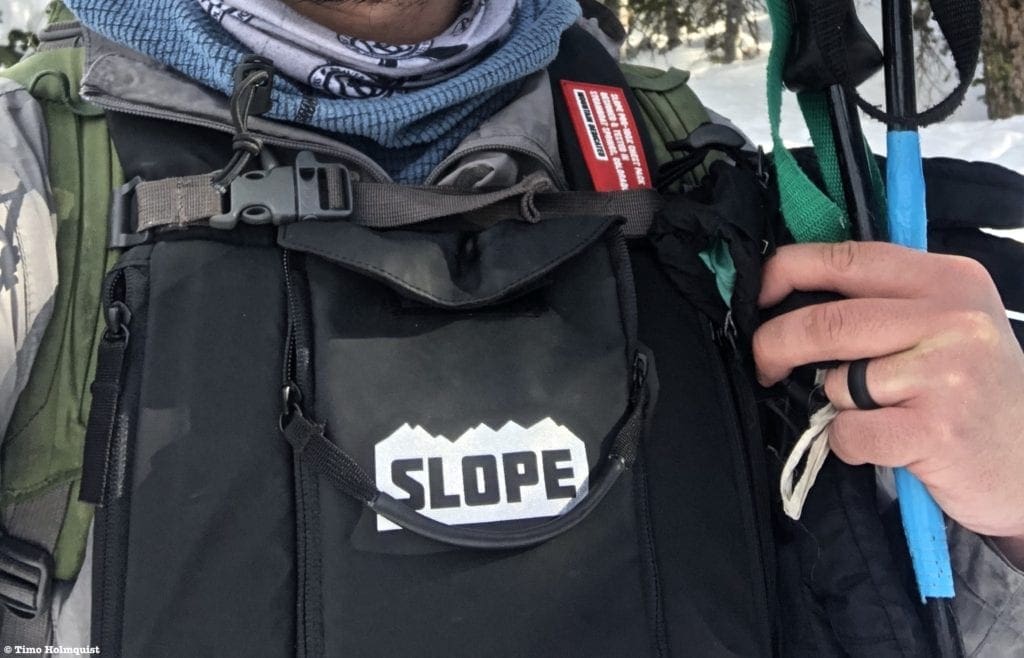
Slope Pro-180x Chest Pack on top of layered cold-weather clothing.
What it Is: Description, Cost, and Specs
The Slope Pro-180x is the flagship product of a small company based in the perennial outdoor mecca of Steamboat Springs. The main website, click here, is sleek and brings your attention immediately to the design and functionality of the pack. The Slope Pro-180x is currently the only product listed on the website, but the review section had some glowing words, so I was keen to test it out.
The pack is a front-facing chest pack designed to be worn around the outside most layer that you’re wearing. Adjustable straps and clips make it relatively easy to put on and take off. The material that touches your chest is comfortable, keeps you warm, and doesn’t rub or scratch against the outer shell. As far as colors and customization go, black is the only available model, although it fits with most anything you would be wearing. The pack also comes with a complimentary 0.5-liter collapsible water bottle, which is a nice touch, although not nearly enough water for most outdoor activities. The pack is light, the straps are adjustable, and it has enough capacity to hold about a dozen small items.
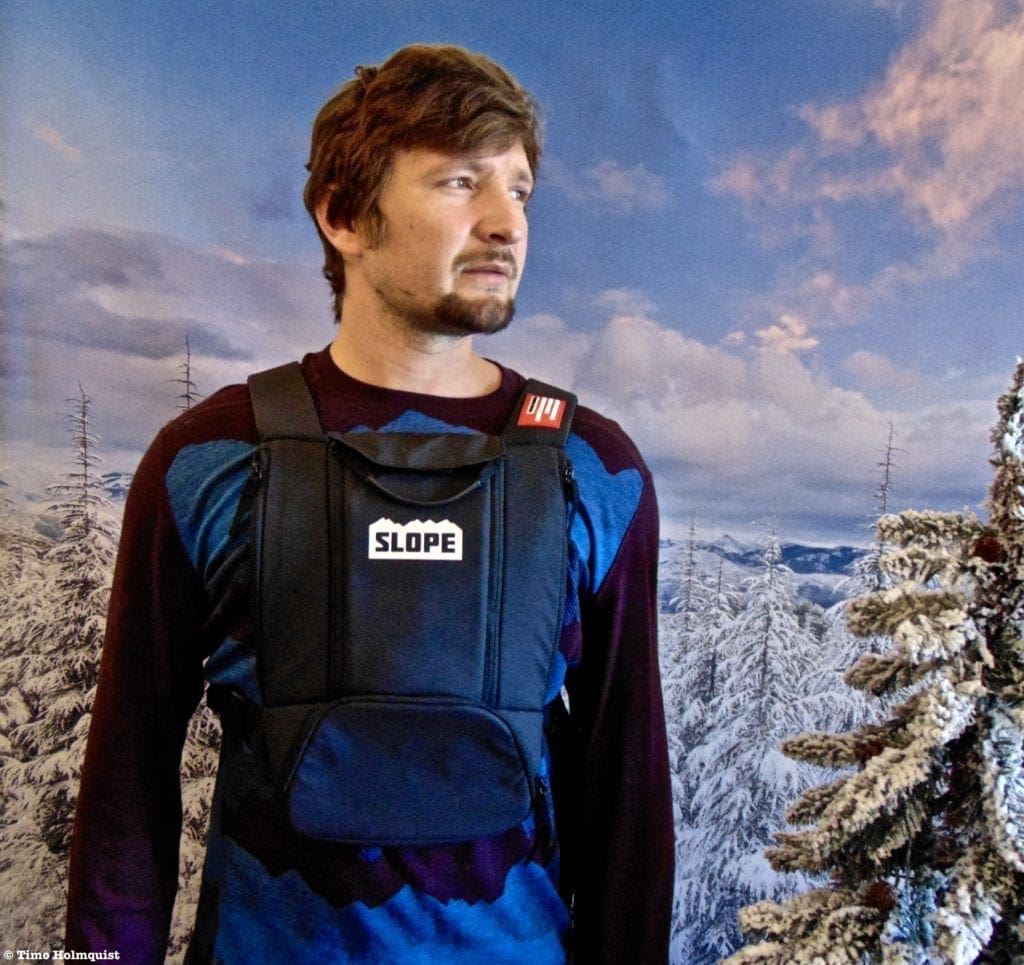
How the Chest Pack sits.
Cost:
- $99.99.
- Mid-April 2021 sale price of $79.99
Specs:
- Dimensions: 13.4” Long, and 10.2” Wide
- Weight: 15 oz
- Capacity: 6 L
- 1 front pocket with cell phone holder & two other padded sleeves
- Red lanyard with clip on the end for extra attachments
- 1 large side pocket for collapsible water bottle (insulated for quick hand warmth)
- 1 bottom pocket for goggle lenses, snacks, etc.
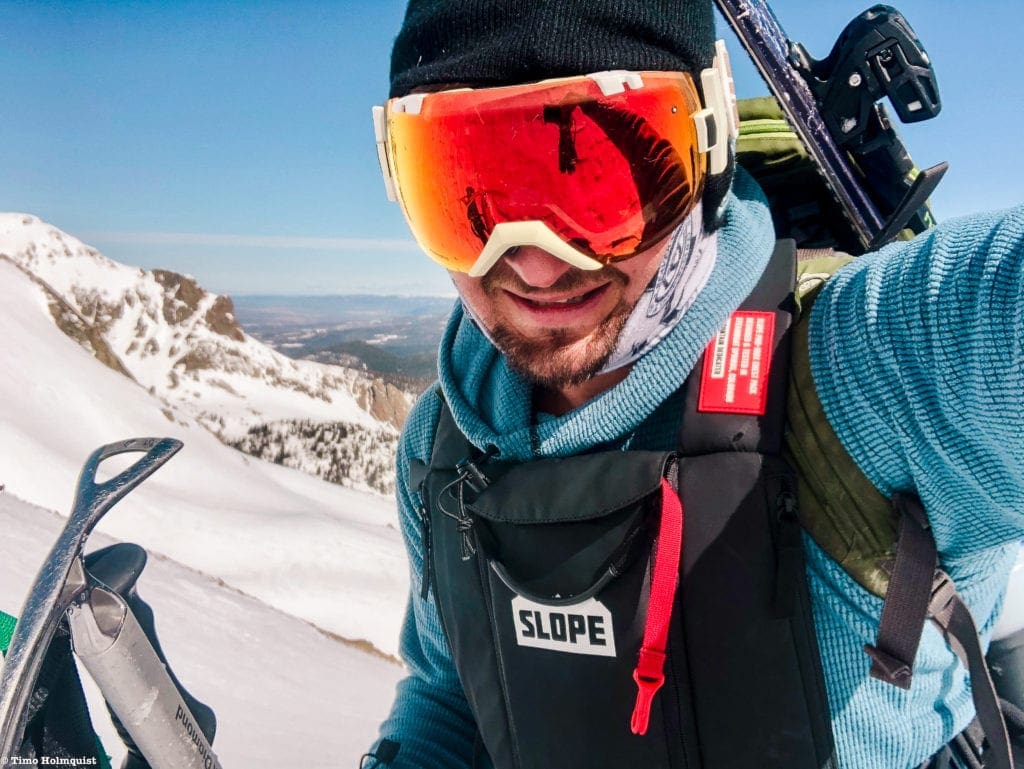
Pack in action with red lanyard visible.
What It’s For:
The Slope Pro-180x Chest Pack is geared towards multiple cold-weather sports with a strong emphasis on resort skiing and snowmobiling. While light, the pack has some great insulation and is meant for quick access to materials without the hassle of rummaging through a larger backcountry pack. You can use it effectively at ski resorts for a quick swig of water or to carry around some extra food; additionally, you can load chairlifts without worrying about straps getting caught in the chair. While I didn’t test it on a snowmobile, having been on plenty before, the pack would fit right at home in that arena as well. This is not an ideal product for warm/hot weather activities; however, if a shorter hike or mountain bike adventure takes you into colder climes, I’d consider it.
Its functionality in the backcountry was less apparent to me when I first came upon the pack, so I wanted to take it out a few times and see how it would (or wouldn’t) fit in with my normal routine.
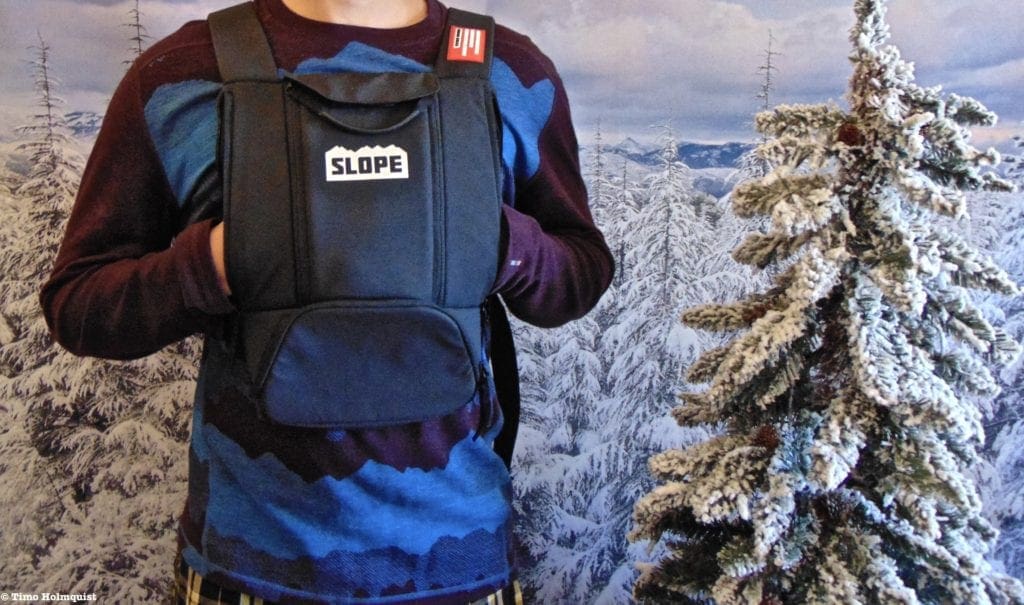
Highlighting the insulated pocket for hands.
How to Wear It
The set-up is like a front-facing harness with a black square that fits between and below your shoulder blades. You shift into it diagonally after unclipping the one hip clip and ducking your head under the left shoulder strap. Then, drop into place, adjust the straps, and voila, it is on.
Pay attention to the straps that wrap around your back so they don’t twist. I had this happen a couple of times when I first began messing with the pack, and while it has not been a problem since, it is worth watching for, especially if you’re putting it on in a hurry. Twisted straps sit awkwardly and can create pressure points along your back.
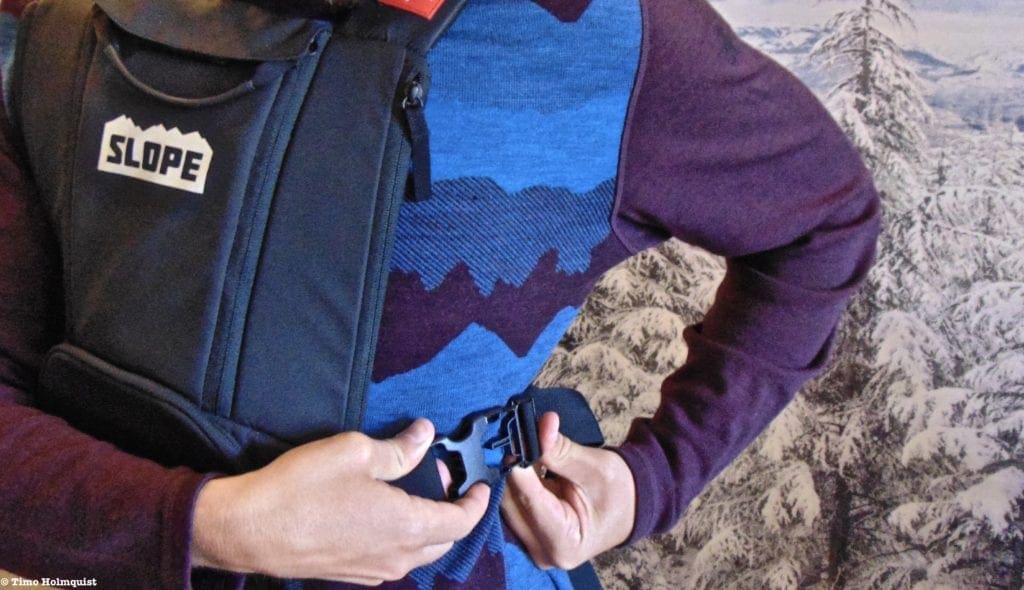
The side clip.
For longer backcountry days, and if packing avalanche gear, you’re going to want to bring a bigger backpack in addition to the Slope. While this seems like a lot, the benefit of easy food, water, and phone access from your chest, along with an insulated pocket for your hands, are enough reasons to consider it. I didn’t experience any unusual discomfort, aside from the regular pressure of wearing a backpack on an outdoor adventure, and felt that it didn’t inhibit movement. I usually readjust the pack one to two times on the way up, and then it feels right.
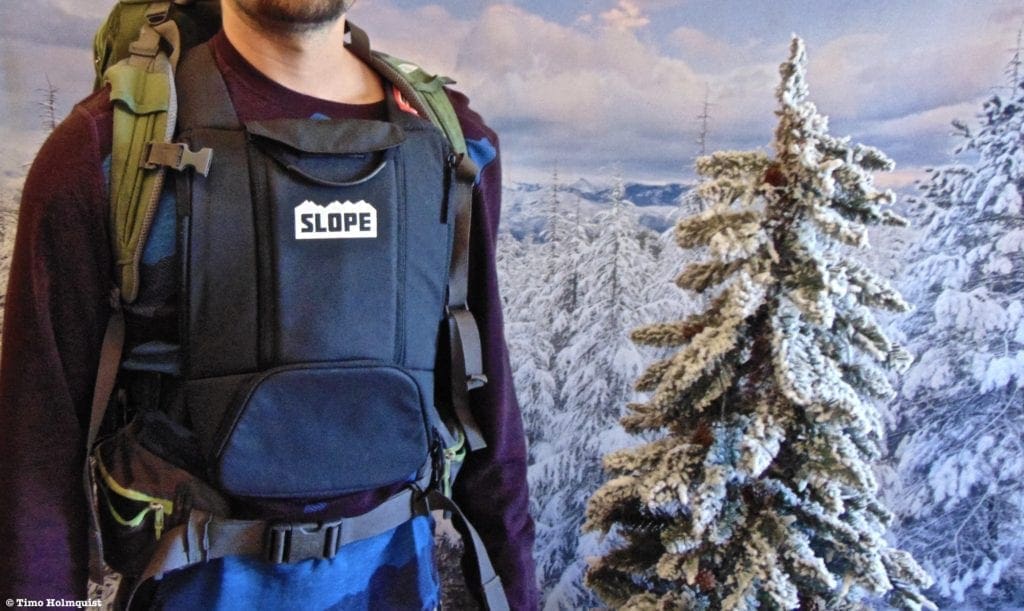
Photo with Chest Pack and a 50L Backpack on.
What it Fits:
A decent amount, considering its size.
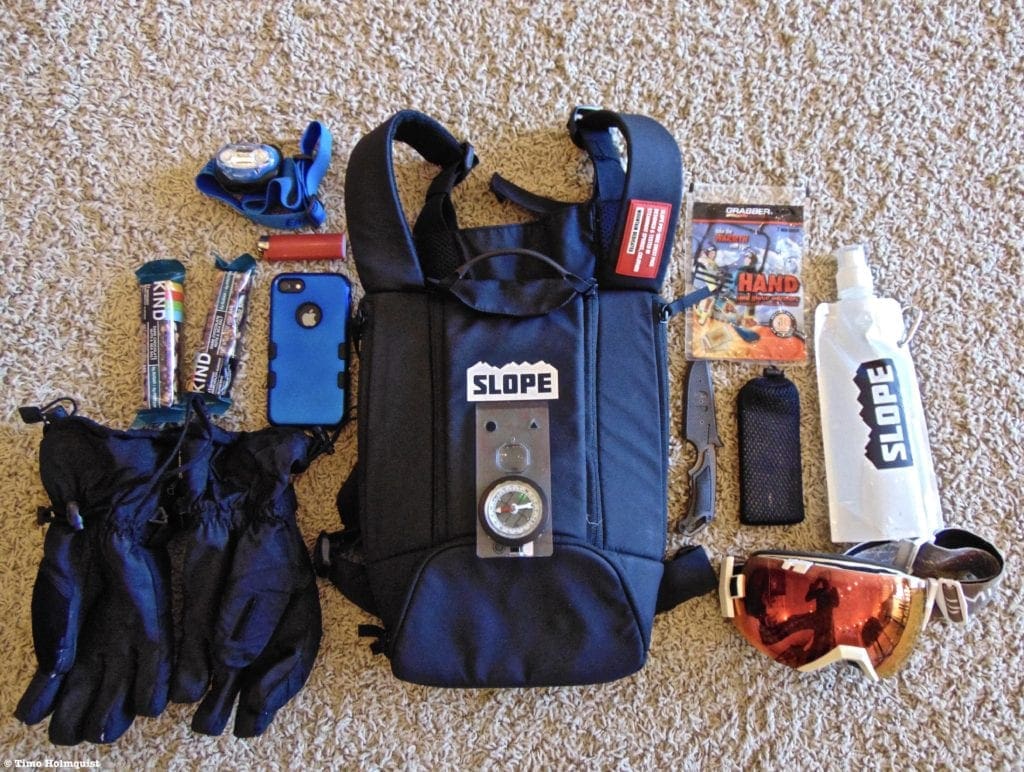
Empty Slope Pro-180x Chest Pack with a collection of items around it.
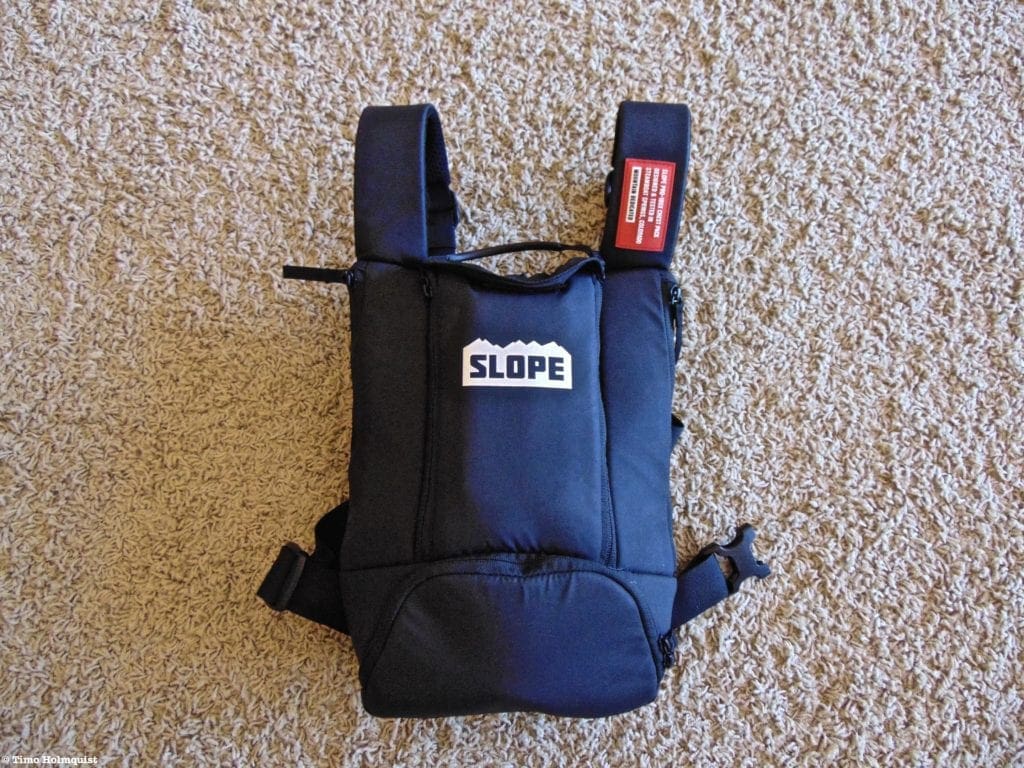
Full pack stuffed with items seen in the previous photo.
What I liked
The insulated pockets were a particular highlight during my windy backcountry adventures. There’s a handy cell phone pocket right in the front, which helps when you want to take quick photos and stow your phone before your fingers freeze. Per their website, a full-size water bottle could fit inside the bigger pocket, but they recommend the collapsible water bottle variety, and I see why; it’s just much more comfortable. As previously mentioned, it comes with a 0.5-liter collapsible bottle, but my recommendation is to take at least double that; half a liter isn’t a lot of water. A 1-liter collapsible bottle will fit nicely into the main pocket.
On the subject of water: during my first gear test with this pack, both of my Nalgene’s, which I carried on the outside of my larger pack, completely froze. I was quite happy to find that the extra liter I’d stuffed into the insulated pocket of the Slope Pro was 100% liquid and ready to drink. While newer Camelbacks have a sleeve to help with kind of situation, I’ve had them freeze on me too. If you like to get after it in winter/alpine spring conditions, frozen water can be a serious problem. I’m pleased to say the Slope Pro-180x came through in a big way.
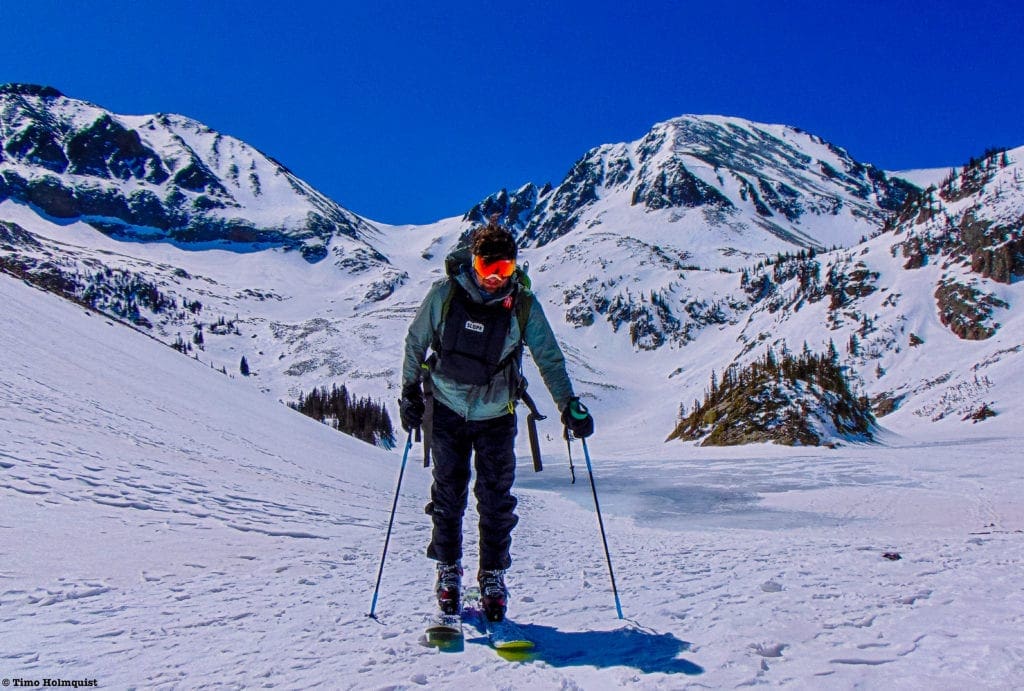
Skiing along the shores of Lake Agnes.
I was also happy with how warm the pack kept my chest. Depending on the wind chill and what kind of layers I’ve brought with me, heat loss in the chest area can be significant. As I mentioned in the intro, Front Range wind can be brutal, and the chest pack really helped keep my body temperature in check.
Two of the three pockets come with standard zippers, which are easy to operate. The zipper I was most concerned about was the cell phone pocket one, which consists of two zippers and a handle attachment between them. I thought it could be a problem if the zippers aren’t aligned, and it all gets stuck. Those concerns didn’t materialize for me, and for context, I’ve taken the pack out multiple times into the backcountry. The pockets were sturdy, and I enjoyed the efficiency of being able to reach critical items without removing my pack.
Don’t forget about the bottom pocket! Multiple times during my testing, I found the bottom pocket to be a really nice option for things like microspikes, gloves, goggles, or beanies. Again, the convenience of the Chest Pack completely alleviated the need to stop, open my big pack, stow everything, re-shoulder, and go.
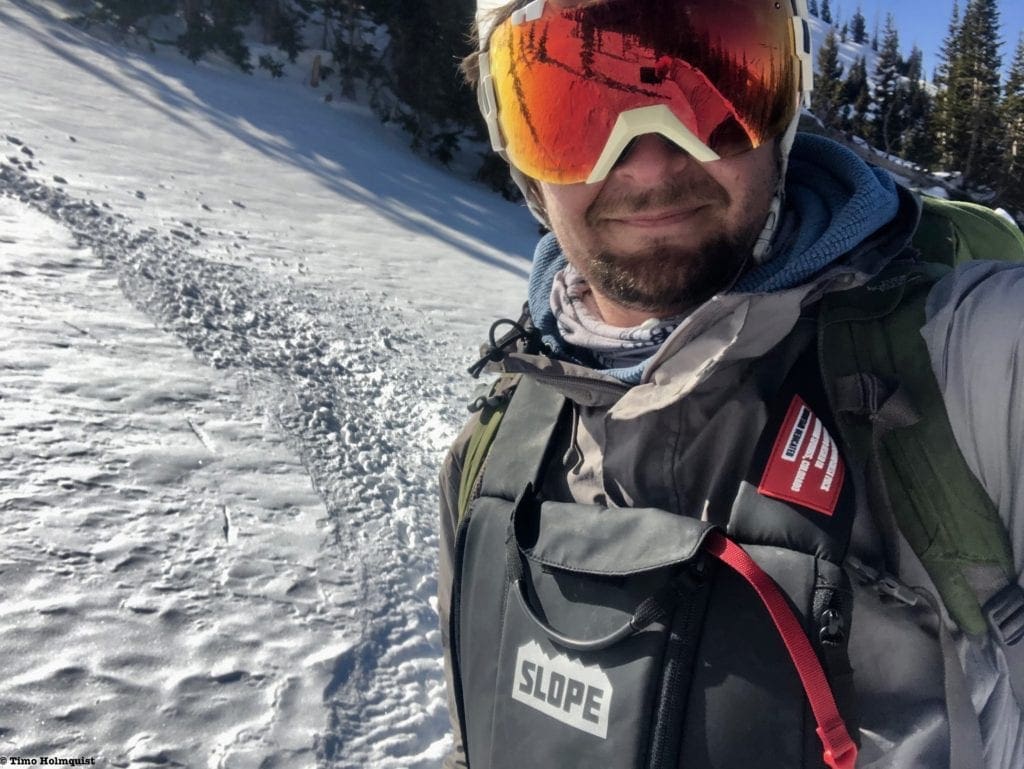
Backcountry turns with the Slope Pro-180x Chest Pack.
The Slope Pro isn’t 100% waterproof but handled well in windblown snow. I wouldn’t dunk it in a lake and expect it to stay bone dry, but for backcountry purposes, it works fine.
The Slope Pro could also be used during multi-day adventures as a sturdy day pack. I wouldn’t recommend it by itself for massive undertakings, but it would be efficient for ~1-5-mile summit days or campground exploration, etc., assuming you come in with a larger backpacking setup as well. The Slope Pro was pretty comfortable when worn at the same time as my larger backcountry pack. I thought there might be some weird rubbing along the shoulders or twisting of the pack body, but once I adjust the side straps to cinch it down, the pack stayed where I wanted it to.
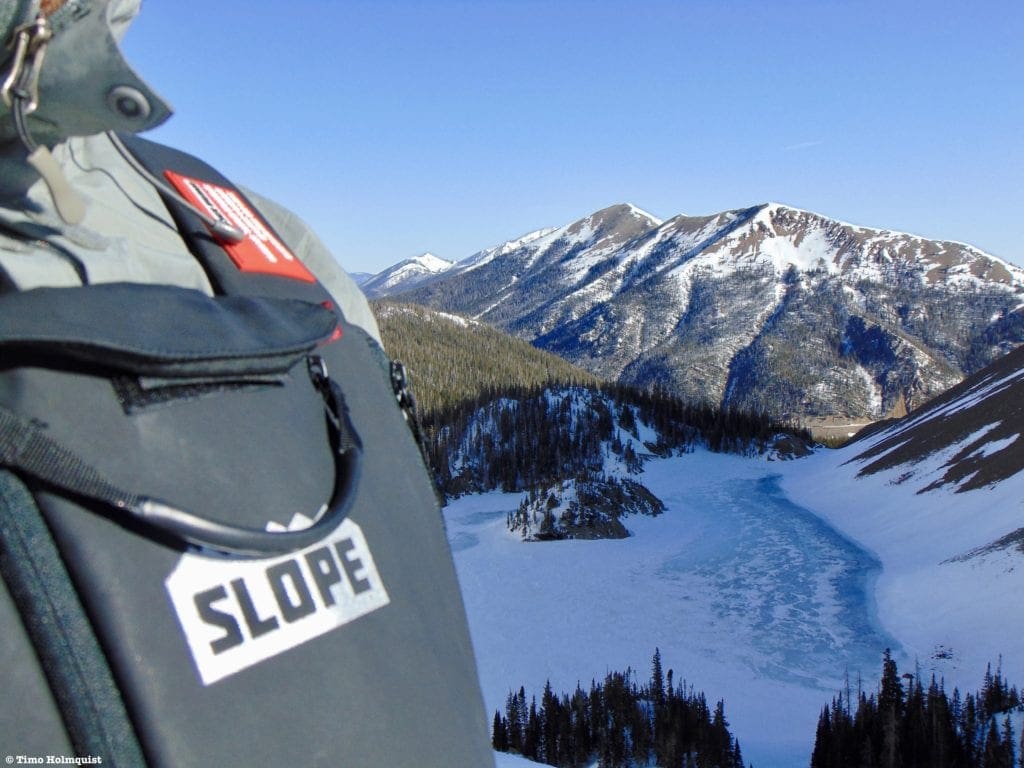
The Slope Chest Pack on an alpine ascent.
What I didn’t Like
When used in combination with a regular backpack for backcountry skiing, you may need a few extra minutes to line everything up. I was able to clip my regular backpack’s hip clip around the bottom of the Slope Pro-180x easily but found it a bit harder to do with my chest strap, especially when the Chest Pack was full. You can wear both the Slope Pro-180x and a regular backpack on longer adventures, but not all straps cinch perfectly, and small adjustments will be necessary as you assess how the packs sit when you move.
Speaking of straps, while I managed to get everything to fit well, it did take a while. In fact, when first trying the pack at home, I had to have the assistance of mirrors and extra hands to truly center everything. The side straps are easy to pull and tighten on your own, but the shoulder straps are pretty hard to cinch if you’re not double-jointed. If it’s just you adjusting the pack, set the shoulder straps BEFORE heading out on an adventure.
While the zippers on the insulated pocket were very easy to operate, I found some online reviews that said during hard-charging descents, the zippers could loosen. Determined to mimic “hard-charging” conditions, I was also a bit disappointed to see that one of the zippers popped open. Nothing fell out, and it only happened once, but a locking mechanism on the zipper would prevent this.
In a multi-day scenario, ideally, you’d want the Slope Pro-180x to either be worn, shoved inside a larger pack, or clipped onto the back of a larger pack. While all three scenarios are possible, with multi-day weight on your back, the Slope would be uncomfortable to wear if you start sweating heavily. The Slope Pro also takes up more room than I’d like in a 50-liter pack, and clipping it onto the back of your larger set-up may take space away from where something like where a sleeping pad might go.
The pack can certainly be used on its own for half-day outings, but it’s best to have cooler and temperature consistent days. If you only take this pack and the temperature spikes 30 degrees throughout the day, a not uncommon occurrence in Colorado, you’re going to want to shed layers. There isn’t enough room in the Slope Pro-180x to stuff in more than a shell without sacrificing space for other items.
Ratings:
In the backcountry skiing realm, there are two basic ways to use the Slope Pro-180x Chest Pack, on its own or in combination with a larger pack.
- On its own: 4 of 5 Stars for half-day colder weather outings when avalanche danger is minimal to non-existent (ALWAYS check CAIC). Not enough room for avalanche gear, so not recommended as a solo pack for more intense outings.
- With Backcountry Pack: 3.5/5 Stars. While it fits well in combination with larger packs, this is a personal preference category strongly influenced by body type, how effectively you can cinch down straps, and where pressure points crop up.
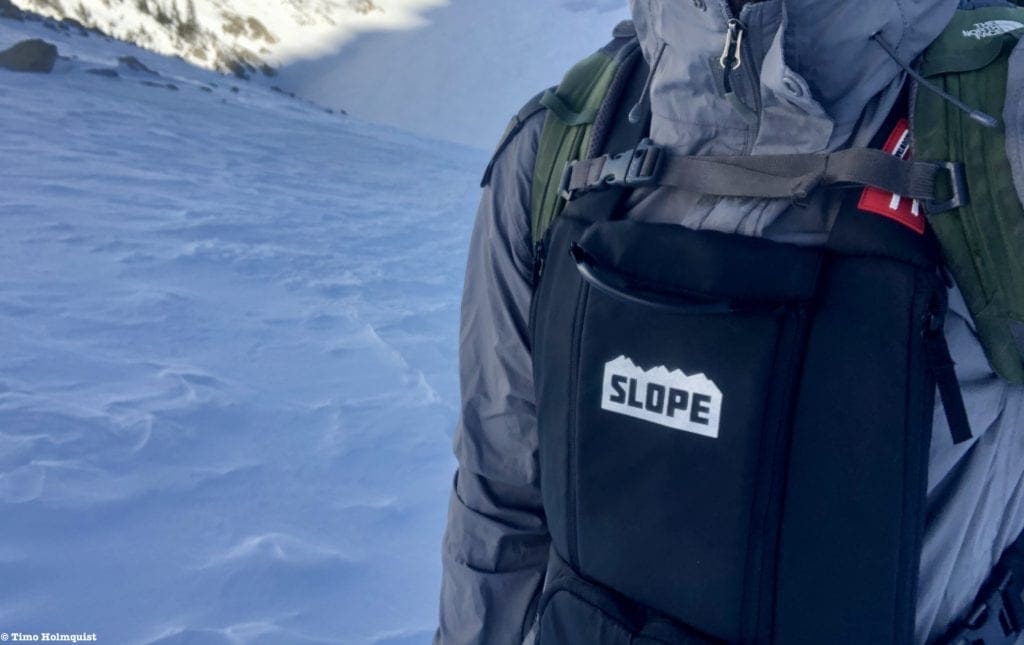
The Slope Pro-180x worn with a larger backcountry pack.
Final Thoughts:
The Slope Pro-180x Chest Pack pairs well with resort skiing/riding, snowmobiling, casual snowshoeing, cross-country skiing, and backcountry skiing; it would also be nice for cold-weather mountain bike trips. It can be worn in combination with a regular fitting backpack, although you’ll need to spend a little time making sure both packs sit well on your body. If this is your only pack, I’d recommend keeping it to half-day adventures where ~1 liter of water will suffice. While there is plenty of space for a number of smaller items, the pack will not be able to hold multiple layers of clothing should temperature fluctuations force you to peel or add layers.
I usually try to backcountry ski between 10-15 times a year, and I can see bringing the Slope Pro-180x on most of those adventures. The downsides aren’t enough to take away the benefits of insulated pockets, chest warmth, quick access to water, snacks, phones, and navigation tools. If you’re heading out into the backcountry, and are unsatisfied with your current setup, consider adding the Slope Pro-180x Chest Pack.
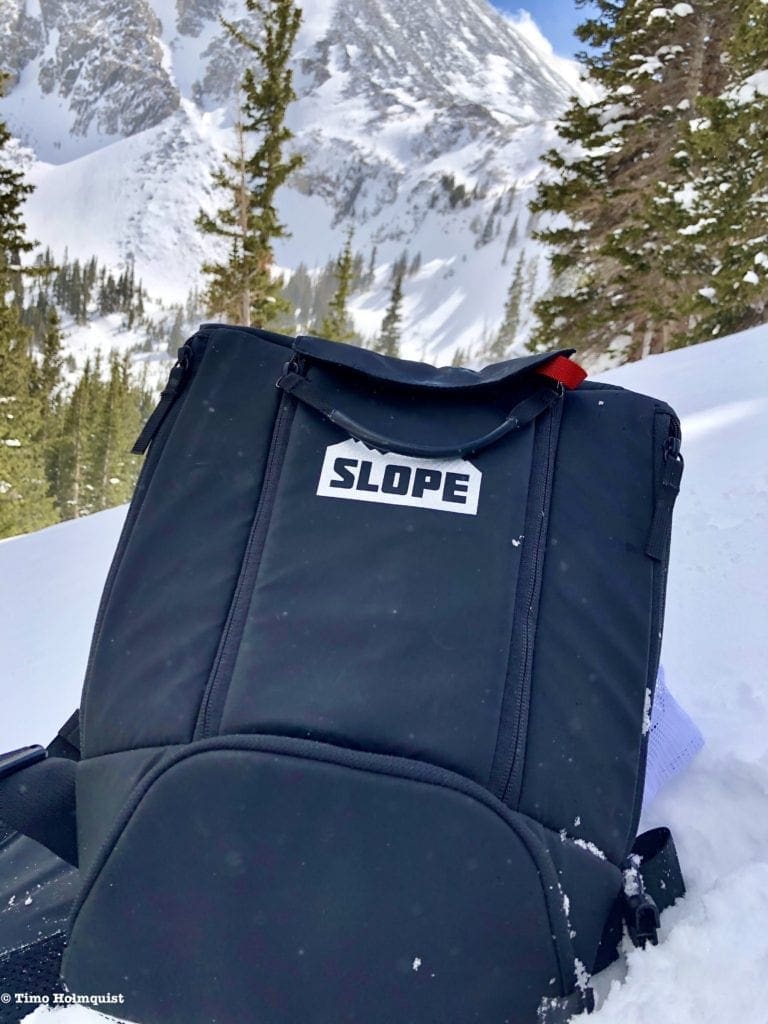
Slope Pro-180x in the wilderness.
Backcountry Ski Gear: Essentials for Human Powered Skiing
Guide To Planning A Backcountry Ski Adventure
Backcountry Skiing in Rocky Mountain National Park: Hidden Valley and Sundance Mountain Ski Lines
Backcountry Skiing in Rocky Mountain National Park: Bear Lake Area Ski Lines
Backcountry Skiing in Rocky Mountain National Park: Longs Peak Area Ski Lines
Best Places To Backcountry Ski in Rocky Mountain National Park, Colorado: Best of the Rest











